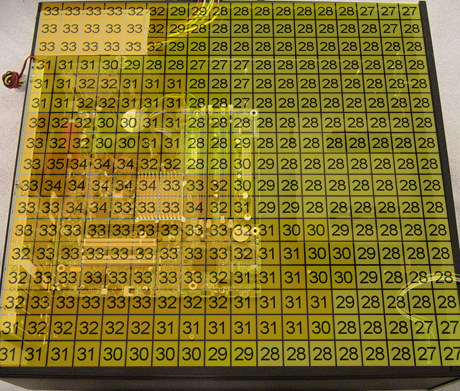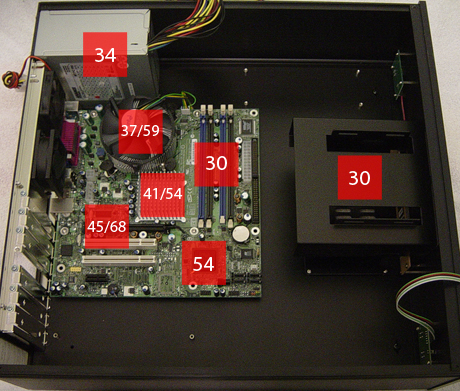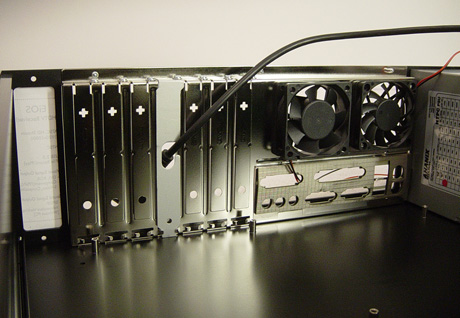Intel's Long Awaited BTX Form Factor
by Purav Sanghani on November 15, 2004 5:31 AM EST- Posted in
- Cases/Cooling/PSUs
Thermals Desktop ATX
We tested our D915GUX board and Pentium 550 CPU in Ahanix's D.Vine 5 HTPC chassis, the successor to the D.Vine 4 we reviewed last month, since it had the size of a typical mid tower case yet took on the form of a flat lying desktop case like the B300 to give a better idea of how this hardware performed in a case with sizes we are used to. Unlike Opus Technologies, Ahanix has a great deal of products, many of them cases which is their main focus. The first case we reviewed from Ahanix was their Black Knight. The Black Knight performed well in our thermal benchmarks while averaging at 50dBA in sound We again measure temperatures of the ambient air inch by inch to show how each component affects various areas of the case.
Click to Enlarge
It is evident that the warmest region in our desktop ATX system is between the CPU, Northbridge, and PCIe VGA card followed by the power supply. We also notice how the rear exhaust fans are pulling the warm air towards them to the outside. The D.Vine 5 has an extremely large footprint, 17" in width by 18" in depth, so there are many areas which are not being exposed to warm air such as the front corners as well as the left side of the case.

Click to Enlarge
We see here that the CPU, Northbridge heatsink and the PCIe VGA card are the hottest components in the system. The Southbridge also ran extremely hot at 54 degrees, but it is too small to have as great of an effect on the ambient air around it as did the other three. The power supply, on the other hand, measured to be 34 degrees which had a great affect on its surrounding air.

Click to Enlarge
Again, since the D.Vine 5 lies flat instead of upright like the TT-501 does, heat pockets mainly occur over the equipment giving off the heat instead of at the top of the case (the right side in this case) near the power supply.










77 Comments
View All Comments
sprockkets - Monday, November 15, 2004 - link
Not at all 48#.The move from AT to ATX, wonderful, nice, a big improvement.
ATX to BTX, err, why?
Well, I do see a need to have this in place with LOW PROFILE cases. Otherwise, the ventilation is terrible. And pBTX looks nice too. BUT, all you are doing is standardizing the design of small case designs, something that those poor OEMs had to do (aww, poor dell doesn't have to design utterly poor cooling solutions, like the ones we have at work, where the case doesn't even have front air intake, and the processor gets cooled from the very air it exhausts, sad). Large cases such as ATX do not need this.
Hmmm, doesn't that L shaped power supply bring back GREAT memories?
Add to it, why didn't video cards get mounted with the cooling on top? That would have helped it a lot with cooling.
For that matter, you people REALLY need to get with the program with InWin cases. Their latest uATX case has a large fan duct for processor fan intake, a large holed opening on the bottom left hand corner for cooling the add in cards, a quiet 90mm fan exhaust and a 120mm fan on the 300w power supply for exhaust.
Bozo Galora - Monday, November 15, 2004 - link
Intel quicksand gets deeperDS Delaroca - Monday, November 15, 2004 - link
so the way i see it, its that for a long period of time we will have to standards for each company, BTX for Intel ATX for AMD, so these means for us DIY computers builders the future its limited by what CPU U choose,as for none of the parts for an AMD system would be not interchangeble with an INTEL BTX system, as it is today that both use the same ATX desing, and i mean u would not be able to use the same PS, video card,sound card and any non BTX complyant part, correct me if im wrong if this correct THANKS.pjarvi - Monday, November 15, 2004 - link
Unless I misread the article, the exhaust is blowing out the front?!? If that's true, then that's really, really, stupid. Every company I've worked for buys dekstop systems, that sit infront of, or to the side, of employess. If BTX is blowing exhaust out the front, then a lot of people are gonna get cranky due to allergies. I know that I personally can't stand a fan blowing air in my face, and hot dusty air is gonna be a million times worse.Nonsense - Monday, November 15, 2004 - link
The airflow described on page 6 is inconsistent:"The CPU, Northbridge, Southbridge, and VGA card are all inline which creates a single path for air to flow and in one single direction, from back to front through the thermal module"
...PICTURE...
"From the picture we see the flow of warm air pulled forward from beyond the VGA card. As it moves towards the front of the case the air flows over the Southbridge and Northbridge passively cooling each chip. "
Now look follow the link at the top of that page: "heat paths in a BTX system" which goes to: http://www.anandtech.com/casecooling/showdoc.aspx?...
Which says: "The redesign of the board layout was done in order to improve airflow through the system; moving the CPU to the "front" of the case allows it to be right next to the intake fan, giving it the coolest air out of any component in the system. You will then notice that the chipset is directly in line with the CPU, allowing airflow over the CPU's heatsink to be channeled over those heatsinks as well before exiting the case."
These two articles directly contradict of each other. I think the latter is correct. Please post a correction, thank you.
PsharkJF - Monday, November 15, 2004 - link
Fat fingers for ATX ;]Chuckles - Monday, November 15, 2004 - link
OK, so after all that, I have only one question. Why in the name of $DIETY are they venting out the front of the case? Do they want the dust bunnies to have a home? Why not flip the components around and (with a little coercion towards the graphics card manufacturers) vent all the hot air out the back?Also, to those that think AMD is immune to the heat problems: Power consumption (and dissipation) has gone nowhere but up in computers. Heck, ten years ago CPU's didn't have a heatsink, much less one with a fan. With increased heat has come to be expected more noise. I personally think BTX is a stumble in the right direction towards reducing the noise while dealing with the heat output of modern and future micorprocessors.
ZobarStyl - Monday, November 15, 2004 - link
Yeah 48, what about the guy who's pissed cuz he can't do a P4 to P4 upgrade because the damn thing is now obsolete for the mobo AND Case/PSU? And all the HP/Compaq old school jokes are true; this looks exactly the same, and will have all the same problems.The issue isn't so much that we hate Intel, it's that they are a) forcing this on us and b) it has little tangible benefits to necessitate the cost and some of c) AMD chips may not be able to use the standard, but have no need for it anyway. Mostly, we're all tired of Intel moving the industry around wherever and whenever it wants to make up for its own downfalls.
bob661 - Monday, November 15, 2004 - link
#48No one needs it but Intel. It doesn't take a "fanboy" to see that. AMD does NOT have the heat issues that Intel does. That's just a fact. There are some here that hate Intel but some do not. I will only buy what gives me the most bang for my buck. Intel does not provide this at the moment. So I will continue to buy AMD unless that changes. There are others here with the same mentality. No hating involved.
five40 - Monday, November 15, 2004 - link
I'm not a fan boy of intel or amd but so much blatant dislike of intel is sad. It seems that if AMD came up with this standard you guys would be saying how amazing it is and that you want it ASAP. Since it's Intel, no one "needs" it.